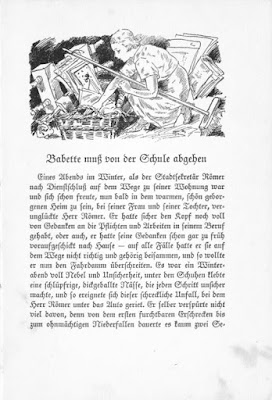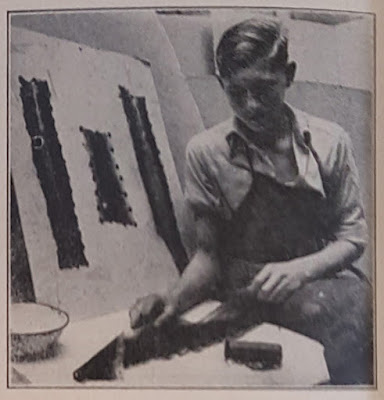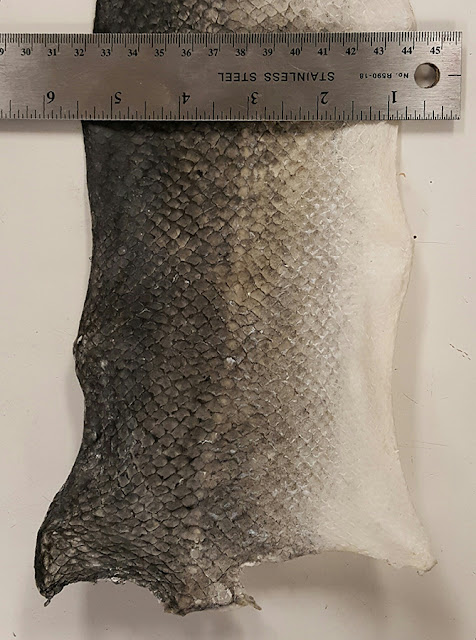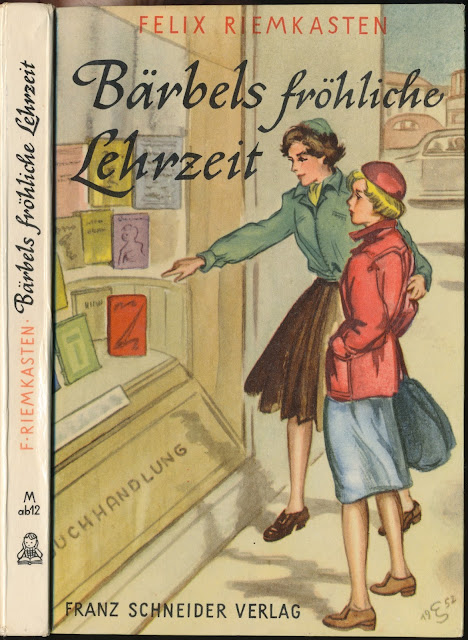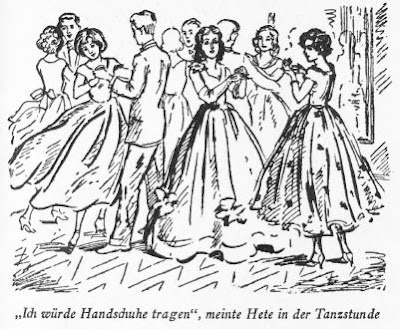Introduction: This series of posts was prompted by questions from Sarah Kim, a long-term work-study student of mine at Syracuse University Libraries who is now enrolled in the Bookbinding program of the North Bennet Street School in Boston, fulfilling a dream she’s had for some time. The “interview” is spread out over several posts, so check back regularly… This is Part 2. See here for part 1, part 3, part 4.
Sarah: Ok, so our experiences as college students were similar, at least as far as the work-study job went. But why Germany, weren't there opportunities in the US? What was a formal apprenticeship like? Why did you end up returning to the US and what were your next steps?
Sensing my interest, John Dean (talks about his own training starting page 7) who had served a traditional apprenticeship and worked in the UK before emigrating, and Frank Mowery who studied bookbinding with Wiemeler student Kurt Londenberg in Hamburg and later conservation in Vienna, both encouraged me to take advantage of my dual-citizenship and formally apprentice in Germany where there was a very structured and rigid apprenticeship system. I knew the language and was familiar with the culture, but not in the way I thought...
In the US, the options were more limited with the conservation program in the library school at Columbia University being the best option, with lots of coursework in library preservation, conservation science, but not so much bench time. North Bennet Street School did not have a bookbinding program at the time. Formal apprenticeships were also very hard to come by and unstructured. My goal was to work in library conservation for special collections materials, so a very solid foundation in the craft of bookbinding was a must. So, apprenticeship it was, and Germany the natural choice...
Apprenticeship in Gelsenkirchen, Germany
Apprenticeships were regulated by the Guilds on a regional and national basis, and apprentices were expected to work to the Rahmenlehrplan (in German) that outlines the terms of the apprenticeship, learning outcomes tied to a calendar, topics to be covered, ... Also included was the trade school requirement. Apprentices were tested on this after the second year, and then the third (the final). All test questions and practical exercises were the same nation-wide. This system helped ensure that the binderies knew what to expect from the newly minted Journeymen in terms of hands-on skills, the ability to estimate jobs (materials usage and time), and the overall structure of the trade. After all, they would need this solid foundation if they wanted to become Meister, open their own bindery, and train apprentices. All required.
 |
| Excerpt from Rahmenlehrplan. Click to enlarge. |
There are three inviolable rules that apply to all apprentices, in all trades, everywhere:
- The Meister is always right
- The apprentice is always wrong
- If, in the event of a disaster, the apprentice happens to be right, they are still wrong.
 |
| Being shown the door if complaining - many looking for
apprenticeships… A Schreinerei (on door) is a carpentry shop. Different tools and products, same system… |
Despite feeling prepared for apprenticeship due to my work-study and internship experiences, perhaps even ahead of the curve, my start as a “stift” (lowest grade apprentice) in this system was (and still is) challenging as it was not always politically correct or comfortable. So, I needed develop a thick skin. This took me longer than I thought, and many of the other apprentices I knew, especially those that had gone to university or were qualified to do so had similar experiences.
 |
| Buchbinderei Klein where I served my apprenticeship. It was in the Künstlersiedlung Halfmannshof (an artist's colony started in 1931), by far the most attractive bindery location to work in. An island of bucolic tranquility in a declining industrial landscape. Interesting note, the bindery was mentioned by name and location in The Book of Air and Shadows (pp28-29) by Michael Gruber |
 |
| Interior: note the neat and orderly stacks of jobs in progress... Orange and blue (Syracuse University colors), who would have thought? |
The bindery itself was staffed by the Meister, his wife who was a journeyman and completed her Meister shortly after I left, another apprentice (2 years ahead of me), and occasionally when we were really backed up another journeyman. In a small shop like ours, the staggering of apprentices makes good sense as you need continuity and the junior apprentice learns a lot just from watching the senior apprentice work. In terms of becoming a Meister, there were, of course, all the finer techniques one needed to know, but also all the things associated with managing a business such as accounting, estimating jobs and materials usage (introduced during the apprenticeship), managing staff at all levels (including all the legal regulations), some marketing. In short everything needed to succeed, at least on paper.
As apprentices we were fully integrated into the production workflow of the shop based on our abilities. Without us, everything grinds to a halt. First jobs were cleaning up, sorting supplies, cleaning brushes, ... One could not help but get they feeling that "they" let the shop go for a while in anticipation of the new apprentice. While tedious and perhaps "degrading," it taught you what the materials were, how to handle them, where they were stored, their value, ... Looking back, even if not tasked with it, I looked at all those places and things in each job thereafter. We were given basic tools, but expected to acquire our own as we progressed. This also drilled into us the care and maintenance required so that they would last - can't do good work with bad tools... A professional uses their own tools and maintains them, period. Buy the best you can (barely) afford.
We largely did library binding by hand in batches of 100ish/week (or so) along with other jobs such as repairs of cookbooks, Bibles, presentation bindings/materials, ... So, folding endpapers, cutting super for spine linings, pulling staples from journals (one staple will trash a guillotine blade and the Meister's mood). While the Meister fan-glued the journals, my job was to put them in the press, one after the other. Then, eventually trim to a template, apply a color to the top edge, endbands, and start cutting materials for the Bradel binding covers... After I had the hang of that, it was time for me to start assembling the cases. My first time, the Meister tested one, then another, then the third... Off to the dumpster the lot of 50+ went, and I got to work late to redo. He made his point. I got more practice in production work and things became second nature. By the end, I was working independently (as much as an apprentice is allowed to) and taking books all the way through to the end, stamping, casing in. The second nature bit is critical so that one can focus on the critical parts of the process, not endlessly comparing thread thickness, groove width, folding... The Guild also required us to keep a daily journal, with one page for notes/essay and a listing of tasks completed with time, all initialed by the Meister.
 |
| Math for bookbinders: Calculating materials needs for covering a quarter binding and and stamping foil. More straightforward than it looks..., sure, we'll go with that... |
Based on my age, trade school was not required, but I quickly learned that the only way I would pass my final examinations was by going. Trade school was the great equalizer, teaching the skills that were necessary for the exam, math for bookbinding (estimating prices, calculating materials needs, ...), social studies (Because traditionally kids who left school after 8th grade needed to continue their development as informed citizens), structure of the trade, theoretical knowledge for binding, and technique. Also included were use of machines, BIG ones such as those used for folding on an industrial scale, or 2 meter guillotines that we needed to program and change blades on, solo. Our teacher for the machines had mangled hands, also missing a few fingers. He waved them as he reached into the running machines, and when he said DON'T do "X" we listened. Enrolling myself in trade school, got the Meister and me into hot water with the Guild, and each other. In the end, my apprenticeship was shortened from 3 to 2 years based on my "previous experiences" as a work-study and intern. That last year was "challenging," and I admit that I was a handful at times... (Lehrjahre sind keine Herrenjahre).
Still, I wouldn't trade the experiences for anything, and I have many good memories as well. I am glad we are still in regular contact.I also learned far more in those 2 years than I thought, especially when looking back. It was learning the skills, but more importantly learning how to work, to organize the tasks, workflows, work with materials. Resilience is a good thing, in any work environment or relationship. It makes us stronger and hopefully smarter.
Still maintaining connections back to my old stomping grounds, I sent note from the wilderness, "Report on Bookbinding Apprenticeship in Germany," that focused on daily life, but also on those things that provided inspiration for the conservation career I aspired to - we all dream of medieval books such as "Bibliotheca Palatina Exhibition at the University of Heidelberg"
 |
| My first exhibition binding - the annual national apprentice competition |
With my apprenticeship winding down and realizing that I would not be staying in Germany as there more opportunities back in the USA, I started trying to line up (excessively aspirational) internships and enrolled in the full conservation program at The School for Book Restoration at the Centro del bel Libro in Ascona, Switzerland (yet another note from the field).
 |
| Internship “ding” letters - Vatican postcard signed by the Director. |
 |
| The Masters at the “graduation” ceremony… “If I learned nothing else, it was what not to do,” and “Now I can prove the testing Masters wrong - that I can do better” |
So, I passed my exams (not in any stellar fashion), and knew what I needed to learn and do. Next, pack up my life, mail all my LPs, stereo, press, books, ... back home to the US, and pack my tools, some cloths, my bike, and head down to the beautiful Ticino in Switzerland that I had heard so much about.
 |
| Ascona, elegant living in Paradise (on a REALLY tight budget). |
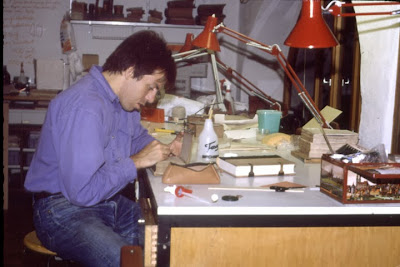 |
| My bench in Ascona during the wooden boards binding class. |
The Centro del bel Libro in Ascona was a therapeutic and transformative experience on many levels and during the 4 months I was there I completed the entire conservation program. This included chemistry for paper and leather (the first time I actually got it!), paper conservation techniques, leather binding, parchment bindings, and wooden boards bindings. Lots of models, and thankfully books to work on thanks to my father and others who sent me some of his treasures. Classes taught by Julia Puissant went from dawn to dusk with longer breaks (and working into the night) if we ended up swimming on the beach or alpine river. The small classes were very international with students from Germany, Switzerland, the Netherlands, Italy, Sweden, and the US during my time. I bought my first Schärfix, bought a wonderful Swiss paring knife I still use, and learned... The Centro del bel Libro also have school for creative binding, similarly organized and then under the direction of Edwin Heim. All the students spent much time together, and it was just wonderful. There were two one week breaks so I headed off to Florence for one, and Milan/Venice for the other.
Chief among the takeaways, other than learning the foundations of various conservation techniques, was that all that tedious repetition really did build muscle memory and “chops,” creating a solid foundation for more complex work. For example, I didn’t need to think about how to sew, but could see that sewing around 2 cords was conceptual the same as one cord, ditto working with leather (paring…), … I really did learn something during my time of servitude. Those lessons and connections became increasingly obvious the further I progressed in my career. I faced many challenges during my apprenticeship (cultural and otherwise) and when I look at the pieces I completed for my final exams I cringe. I knew even then that I could do better, especially with more encouragement, and most important an internal sense of drive to learn, broaden horizons, and seek challenges. For the day-to-day, when tasks become second nature we can focus on the finer points, more easily assimilate other techniques/adapt to changing circumstances as often happens in conservation, and do better work because we are more organized. To get those experiences, I highly recommend working in batches and on editions.
Would I have stayed in the US if North Bennet Street School had existed? It would have been tempting, but I don't think so for reasons that have nothing to do with the school. For me, a big part was seeing if I could return to Germany, back to my roots so to speak, to live and work. I grew up sitting on the fence between the old and new worlds and gave myself a rash. Going back this way was the only way I would find out. Despite all the challenges of my apprenticeship, the idea of working full-time in a bindery and knowing that if you succeed you will know "X" and be able to work most anywhere combined learning with the real world. After 4 years of college, I was ready for something else for a while. I returned for a few reasons, the biggest being that I saw more job prospects with my skill set back in the US and greater flexibility. I doubt I would have had the same opportunities over there.
I'm very glad that we have North Bennet Street School and book arts programs like Alabama and Iowa, never mind the centers throughout the country. For the conservation side, I'm sorry the former Columbia program that moved to UT Austin folded, but am glad it was mostly picked up by at Winterthur, University of Delaware. Ultimately, I lament that the traditional apprenticeship model with defined expectations and structure for both parties, as well as recognized and authoritative credentials never developed here to the same degree. And, even in Germany, the apprentice model in many trades is in decline. There may be numerous reasons for this, economics are a big one. In light of alternatives to "college for all," I am glad to see the idea of formal apprenticeships being considered again. Happy to discuss...
Back in the US
 |
| Not under the stairs with the new bench I built with my father. 4'x8' +, with flat files on one side and a light table that doubles as paring surface on the other. |
After I returned from my apprenticeship and Ascona the end of 1987, I set myself up in “private practice” (this time not under the stairs) with jobs coming from faculty connections. I also started making blank books, but stopped when I realized that people didn't want to pay me what I thought I needed to earn based on time and materials. This allowed me to keep my skills sharp while I looked for a job in the field. To help make ends meet I also got a job at my college bookstore, promptly using the 40% trade discount to buy more books about binding like Tini Miura’s My World of Bibliophile Binding, and Johnson’s Manual of Bookbinding… Good investments, but bad omens of a lifelong addiction. Throughout, I continued to seek guidance from folks in the conservation lab (and access to supplies/equipment), as well as others until getting my first real job in Chicago - perhaps another story - but after working in one traditional hand bindery (Monastery Hill) that had a conservation/extra binding department where I worked, and with renowned conservator Bill Minter for about 3 years. During my Chicago time, I was also able to take advantage of an Mellon Foundation internship with Frank Mowery at the Folger, another transformative experience.
 |
| My bench at the Folger Shakespeare Library, Washington, DC |
 |
| At William Minter's in Chicago |
Despite loving Chicago, the siren call of benefits and longer vacations (very important considerations) pulled me towards working in academic libraries where I spent time at Yale and Cornell (reunited with John Dean), and finally Syracuse where I got to know you, Sarah by way of a book arts I presentation I gave when you were a freshman. During that time I also advanced in “rank,” responsibilities changed and increased, I got an MLS (the "wrong" one, but that was ok), got to establish a conservation lab and program, and ultimately was shifted to a completely different area in a “reorganization.” Because I invested in my own infrastructure since the beginning. I’m still at it with binding and related activities that are now only for my own pleasure, and I feel there is still more I can contribute.
 |
| As Conservator at Syracuse - a staged photo shoot for an article. |
Throughout this who adventure, I was fortunate to be able to count on the guidance, mentorship, and support of those I worked with and got to know as a result of other things like serving on the Board of the Guild of Book Workers, starting Book_Art-L, Book Arts Web, and The Bonefolder, ... Find those mentors early and hold on to them. The relationship will change, but the benefits remain if done right. Join professional groups and consider serving. Join others like Designer Bookbinders and the Canadian Bookbinders and Book Artists Guild for their publications. Start sharing in writing, on listservs and social media, invite dialog, teach to your level of comfort/competence, enter exhibits - get engaged.
You can hear me speak about much of this in "Stations of a Bookbinder's Life: Twenty-five Years in the Field," a talk I gave to the Cornell University Bookarts Club in 2007. In it I discussed my experiences as an apprentice in Germany, work as a binder and conservator, and the many twists and turns my career took. When I was preparing for that, I found a flyer for a similar talk I gave in 1993 (no doubt with photographic slides), but couldn’t find any notes in my “archive.” I did better in 2007.














